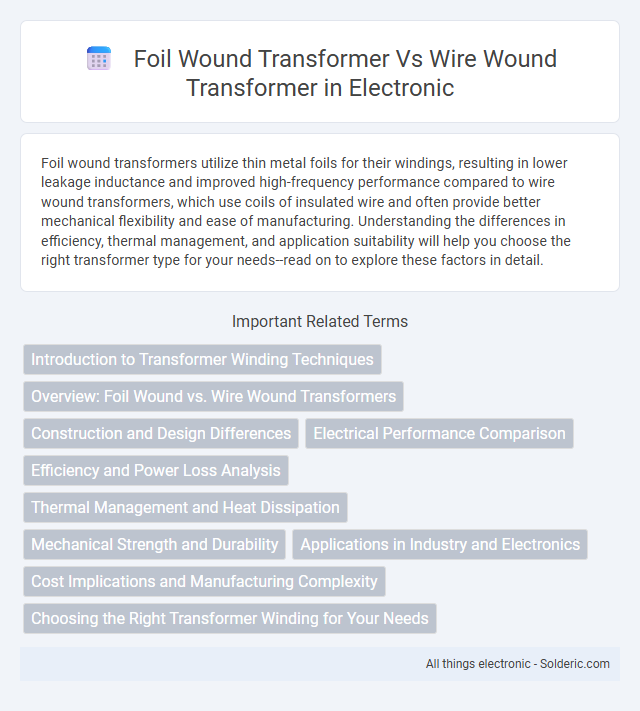Foil wound transformers utilize thin metal foils for their windings, resulting in lower leakage inductance and improved high-frequency performance compared to wire wound transformers, which use coils of insulated wire and often provide better mechanical flexibility and ease of manufacturing. Understanding the differences in efficiency, thermal management, and application suitability will help you choose the right transformer type for your needs--read on to explore these factors in detail.
Comparison Table
| Feature | Foil Wound Transformer | Wire Wound Transformer |
|---|---|---|
| Construction | Uses copper or aluminum foil as winding material | Uses insulated wire coils for winding |
| Resistance | Lower resistance due to larger cross-sectional area of foil | Higher resistance compared to foil winding |
| Current Handling | Better for high current applications | Suitable for lower current or general purpose |
| Inductance | Provides more consistent inductance with reduced leakage | Higher leakage inductance |
| Frequency | Optimal for high-frequency transformers | Used commonly at low to medium frequencies |
| Manufacturing Complexity | More complex and costly to produce | Easier and less expensive to manufacture |
| Thermal Performance | Better heat dissipation and lower temperature rise | Higher temperature rise due to resistance |
| Size and Weight | Generally bulkier due to foil thickness | More compact winding possible |
Introduction to Transformer Winding Techniques
Foil wound transformers utilize thin metal foils as windings, providing lower leakage inductance and improved thermal performance compared to traditional wire wound transformers, which use copper or aluminum wire coils. Foil windings offer enhanced current-carrying capacity and reduced AC resistance, making them ideal for high-frequency and low-profile applications. Wire wound transformers, while more flexible in winding configurations, tend to have higher parasitic capacitances and may exhibit increased losses at elevated frequencies.
Overview: Foil Wound vs. Wire Wound Transformers
Foil wound transformers use thin metal foil as the winding material, offering lower leakage inductance and improved thermal performance compared to traditional wire wound transformers. Wire wound transformers utilize insulated copper or aluminum wire, providing higher flexibility in winding configurations and generally cost-effective manufacturing. Your choice depends on specific application requirements such as efficiency, size constraints, and frequency response.
Construction and Design Differences
Foil wound transformers use flat metal strips wrapped in layers, providing lower resistance and better heat dissipation compared to wire wound transformers that utilize round wire coils. The foil design enables closer winding turns, resulting in reduced leakage inductance and improved high-frequency performance. Your choice depends on the application's need for efficiency, size constraints, and thermal management.
Electrical Performance Comparison
Foil wound transformers exhibit lower equivalent series resistance and reduced leakage inductance compared to wire wound transformers, resulting in improved efficiency and better high-frequency performance. Their uniform conductor geometry ensures more consistent flux distribution, minimizing eddy current and proximity effects that degrade electrical performance in wire wound types. When optimizing Your transformer choice for precise voltage regulation and reduced losses, foil wound designs typically outperform traditional wire wound counterparts.
Efficiency and Power Loss Analysis
Foil wound transformers exhibit higher efficiency compared to wire wound transformers due to reduced resistance and improved current distribution, which minimize power losses. The foil design lowers proximity and skin effect losses, enhancing overall performance, especially under high-frequency conditions. Optimizing Your transformer choice with foil winding can significantly decrease energy losses and boost operational efficiency in demanding applications.
Thermal Management and Heat Dissipation
Foil wound transformers offer superior thermal management due to their large surface area and low thermal resistance, allowing efficient heat dissipation during high current operations. Wire wound transformers, with tightly wound coils, tend to retain more heat, which can lead to increased operating temperatures and reduced lifespan. Advanced cooling techniques are often required for wire wound transformers to ensure reliable heat dissipation and maintain optimal performance.
Mechanical Strength and Durability
Foil wound transformers offer superior mechanical strength due to their continuous metallic strips, which provide enhanced rigidity and vibration resistance compared to wire wound transformers. The foil construction reduces the risk of insulation displacement and winding deformation under mechanical stress, improving overall durability in harsh operating conditions. Wire wound transformers, while flexible, are more susceptible to vibration-induced damage and insulation wear, making foil wound types preferable for applications requiring robust mechanical stability.
Applications in Industry and Electronics
Foil wound transformers excel in high-frequency applications and precise voltage regulation, making them ideal for sensitive electronics such as medical devices, audio equipment, and aerospace systems. Wire wound transformers are preferred in heavy industrial applications due to their robustness, ability to handle higher currents, and cost-effectiveness in power distribution, motor control, and large electrical machines. Your choice depends on the specific industry requirements, balancing performance needs and operational environment.
Cost Implications and Manufacturing Complexity
Foil wound transformers typically involve higher material costs due to the use of thin metal foils and advanced insulation techniques, increasing manufacturing complexity and production time compared to wire wound transformers. Wire wound transformers benefit from more established, automated winding processes that reduce labor costs and simplify assembly, making them more cost-effective for large-scale manufacturing. The choice between foil and wire wound designs directly impacts pricing strategies, with foil wound transformers often reserved for applications demanding superior performance and precision despite higher costs.
Choosing the Right Transformer Winding for Your Needs
Foil wound transformers offer superior high-frequency performance, reduced leakage inductance, and better thermal dissipation compared to wire wound transformers, making them ideal for applications requiring compact size and efficient heat management. Wire wound transformers excel in handling higher power loads and provide mechanical robustness, suitable for traditional low-frequency applications and scenarios demanding durability. Selecting the appropriate transformer winding depends on balancing frequency response, power requirements, thermal considerations, and mechanical constraints specific to your project's needs.
foil wound transformer vs wire wound transformer Infographic

 solderic.com
solderic.com